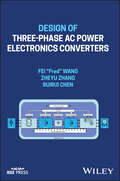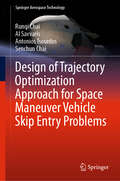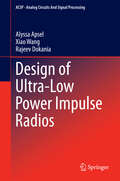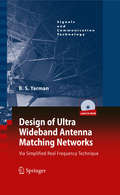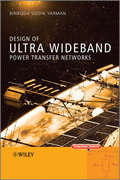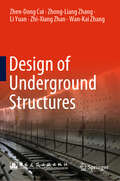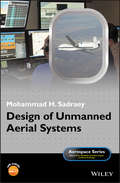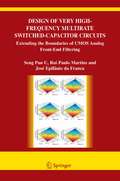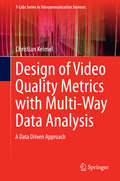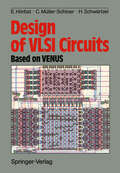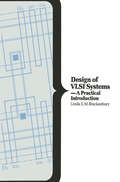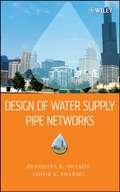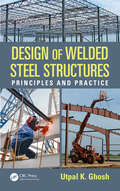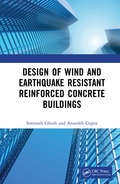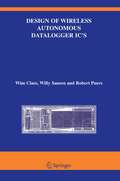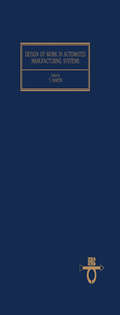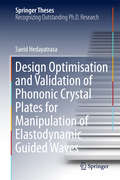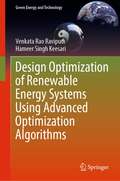- Table View
- List View
Design of Thermal Barrier Coatings: A Modelling Approach (SpringerBriefs in Materials)
by Mohit GuptaThis book details the relationships between microstructure, interface roughness, and properties of thermal barrier coatings. The author proposes a method for the reduction of the thermal conductivity of the ceramic layer in order to increase the lifetime of thermal barrier coatings. He includes models for the optimization of ceramic layer microstructure and interface roughness.
Design of Thermal Energy Systems
by Pradip MajumdarDesign of Thermal Energy Systems Pradip Majumdar, Northern Illinois University, USA A comprehensive introduction to the design and analysis of thermal energy systems Design of Thermal Energy Systems covers the fundamentals and applications in thermal energy systems and components, including conventional power generation and cooling systems, renewable energy systems, heat recovery systems, heat sinks and thermal management. Practical examples are used throughout and are drawn from solar energy systems, fuel cell and battery thermal management, electrical and electronics cooling, engine exhaust heat and emissions, and manufacturing processes. Recent research topics such as steady and unsteady state simulation and optimization methods are also included. Key features: Provides a comprehensive introduction to the design and analysis of thermal energy systems, covering fundamentals and applications. Includes a wide range of industrial application problems and worked out example problems. Applies thermal analysis techniques to generate design specification and ratings. Demonstrates how to design thermal systems and components to meet engineering specifications. Considers alternative options and allows for the estimation of cost and feasibility of thermal systems. Accompanied by a website including software for design and analysis, a solutions manual, and presentation files with PowerPoint slides. The book is essential reading for: practicing engineers in energy and power industries; consulting engineers in mechanical, electrical and chemical engineering; and senior undergraduate and graduate engineering students.
Design of Thermal Energy Systems
by Pradip MajumdarDesign of Thermal Energy Systems Pradip Majumdar, Northern Illinois University, USA A comprehensive introduction to the design and analysis of thermal energy systems Design of Thermal Energy Systems covers the fundamentals and applications in thermal energy systems and components, including conventional power generation and cooling systems, renewable energy systems, heat recovery systems, heat sinks and thermal management. Practical examples are used throughout and are drawn from solar energy systems, fuel cell and battery thermal management, electrical and electronics cooling, engine exhaust heat and emissions, and manufacturing processes. Recent research topics such as steady and unsteady state simulation and optimization methods are also included. Key features: Provides a comprehensive introduction to the design and analysis of thermal energy systems, covering fundamentals and applications. Includes a wide range of industrial application problems and worked out example problems. Applies thermal analysis techniques to generate design specification and ratings. Demonstrates how to design thermal systems and components to meet engineering specifications. Considers alternative options and allows for the estimation of cost and feasibility of thermal systems. Accompanied by a website including software for design and analysis, a solutions manual, and presentation files with PowerPoint slides. The book is essential reading for: practicing engineers in energy and power industries; consulting engineers in mechanical, electrical and chemical engineering; and senior undergraduate and graduate engineering students.
Design of Three-phase AC Power Electronics Converters (IEEE Press)
by Fei "Fred" Wang Zheyu Zhang Ruirui ChenDESIGN OF THREE-PHASE AC POWER ELECTRONICS CONVERTERS Comprehensive resource on design of power electronics converters for three-phase AC applications Design of Three-phase AC Power Electronics Converters contains a systematic discussion of the three-phase AC converter design considering various electrical, thermal, and mechanical subsystems and functions. Focusing on establishing converter components and subsystems models needed for the design, the text demonstrates example designs for these subsystems and for the whole three-phase AC converters considering interactions among subsystems. The design methods apply to different applications and topologies. The text presents the basics of the three-phase AC converter, its design, and the goal and organization of the book, focusing on the characteristics and models important to the converter design for components commonly used in three-phase AC converters. The authors present the design of subsystems, including passive rectifiers, inverters and active rectifiers, electromagnetic interference (EMI) filters, thermal management system, control and auxiliaries, mechanical system, and application considerations, and discuss design optimization, which presents methodology to achieve optimal design results for three-phase AC converters. Specific sample topics covered in Design of Three-phase AC Power Electronics Converters include: Models and characteristics for devices most commonly used in three-phase converters, including conventional Si devices, and emerging SiC and GaN devices Models and selection of various capacitors; characteristics and design of magnetics using different types of magnetic cores, with a focus on inductors Optimal three-phase AC converter design including design and selection of devices, AC line inductors, DC bus capacitors, EMI filters, heatsinks, and control. The design considers both steady-state and transient conditions Load and source impact converter design, such as motors and grid condition impacts For researchers and graduate students in power electronics, along with practicing engineers working in the area of three-phase AC converters, Design of Three-phase AC Power Electronics Converters serves as an essential resource for the subject and may be used as a textbook or industry reference.
Design of Three-phase AC Power Electronics Converters (IEEE Press)
by Fei "Fred" Wang Zheyu Zhang Ruirui ChenDESIGN OF THREE-PHASE AC POWER ELECTRONICS CONVERTERS Comprehensive resource on design of power electronics converters for three-phase AC applications Design of Three-phase AC Power Electronics Converters contains a systematic discussion of the three-phase AC converter design considering various electrical, thermal, and mechanical subsystems and functions. Focusing on establishing converter components and subsystems models needed for the design, the text demonstrates example designs for these subsystems and for the whole three-phase AC converters considering interactions among subsystems. The design methods apply to different applications and topologies. The text presents the basics of the three-phase AC converter, its design, and the goal and organization of the book, focusing on the characteristics and models important to the converter design for components commonly used in three-phase AC converters. The authors present the design of subsystems, including passive rectifiers, inverters and active rectifiers, electromagnetic interference (EMI) filters, thermal management system, control and auxiliaries, mechanical system, and application considerations, and discuss design optimization, which presents methodology to achieve optimal design results for three-phase AC converters. Specific sample topics covered in Design of Three-phase AC Power Electronics Converters include: Models and characteristics for devices most commonly used in three-phase converters, including conventional Si devices, and emerging SiC and GaN devices Models and selection of various capacitors; characteristics and design of magnetics using different types of magnetic cores, with a focus on inductors Optimal three-phase AC converter design including design and selection of devices, AC line inductors, DC bus capacitors, EMI filters, heatsinks, and control. The design considers both steady-state and transient conditions Load and source impact converter design, such as motors and grid condition impacts For researchers and graduate students in power electronics, along with practicing engineers working in the area of three-phase AC converters, Design of Three-phase AC Power Electronics Converters serves as an essential resource for the subject and may be used as a textbook or industry reference.
Design of Trajectory Optimization Approach for Space Maneuver Vehicle Skip Entry Problems (Springer Aerospace Technology)
by Runqi Chai Al Savvaris Antonios Tsourdos Senchun ChaiThis book explores the design of optimal trajectories for space maneuver vehicles (SMVs) using optimal control-based techniques. It begins with a comprehensive introduction to and overview of three main approaches to trajectory optimization, and subsequently focuses on the design of a novel hybrid optimization strategy that combines an initial guess generator with an improved gradient-based inner optimizer. Further, it highlights the development of multi-objective spacecraft trajectory optimization problems, with a particular focus on multi-objective transcription methods and multi-objective evolutionary algorithms. In its final sections, the book studies spacecraft flight scenarios with noise-perturbed dynamics and probabilistic constraints, and designs and validates new chance-constrained optimal control frameworks. The comprehensive and systematic treatment of practical issues in spacecraft trajectory optimization is one of the book’s major features, making it particularly suited for readers who are seeking practical solutions in spacecraft trajectory optimization. It offers a valuable asset for researchers, engineers, and graduate students in GNC systems, engineering optimization, applied optimal control theory, etc.
Design of Ultra-Low Power Impulse Radios (Analog Circuits and Signal Processing #124)
by Alyssa Apsel Xiao Wang Rajeev DokaniaThis book covers the fundamental principles behind the design of ultra-low power radios and how they can form networks to facilitate a variety of applications within healthcare and environmental monitoring, since they may operate for years off a small battery or even harvest energy from the environment. These radios are distinct from conventional radios in that they must operate with very constrained resources and low overhead. This book provides a thorough discussion of the challenges associated with designing radios with such constrained resources, as well as fundamental design concepts and practical approaches to implementing working designs. Coverage includes integrated circuit design, timing and control considerations, fundamental theory behind low power and time domain operation, and network/communication protocol considerations.
Design of Ultra Wideband Antenna Matching Networks: Via Simplified Real Frequency Technique (Signals and Communication Technology)
by Binboga Siddik YarmanDesign of Ultra Wideband Antenna Matching Networks: via Simplified Real Frequency Technique (SRFT) will open up a new horizon for design engineers, researchers, undergraduate and graduate students to construct multi-band and ultra wideband antenna matching networks for antennas which in turn will push the edge of technology to manufacture new generation of complex communication systems beyond microwave frequencies both in commercial and military line. In Design of Ultra Wideband Antenna Matching Networks, many real life examples are presented to design antenna matching networks over HF and cellular commercial multi-band frequencies. For each example, open MatLab source codes are provided so that the reader can easily generate and verify the results of the examples included in the book.
Design of Ultra Wideband Power Transfer Networks
by Binboga Siddik YarmanCombining analytic theory and modern computer-aided design techniques this volume will enable you to understand and design power transfer networks and amplifiers in next generation radio frequency (RF) and microwave communication systems. A comprehensive theory of circuits constructed with lumped and distributed elements is covered, as are electromagnetic field theory, filter theory, and broadband matching. Along with detailed roadmaps and accessible algorithms, this book provides up-to-date, practical design examples including: filters built with microstrip lines in C and X bands; various antenna matching networks over HF and microwave frequencies; channel equalizers with arbitary gain shapes; matching networks for ultrasonic transducers; ultra wideband microwave amplifiers constructed with lumped and distributed elements. A companion website details all Real Frequency Techniques (including line segment and computational techniques) with design tools developed on MatLab. Essential reading for all RF and circuit design engineers, this is also a great reference text for other electrical engineers and researchers working on the development of communications applications at wideband frequencies. This book is also beneficial to advanced electrical and communications engineering students taking courses in RF and microwave communications technology. www.wiley.com/go/yarman_wideband
Design of Underground Structures
by Zhen-Dong Cui Zhong-Liang Zhang Li Yuan Zhi-Xiang Zhan Wan-Kai ZhangThis book provides a general review of the literature on underground structures, combined with new specifications, engineering case studies, and numerical simulations based on the authors’ research. It focuses on the basic concepts, theories, and methods of the design of underground structures. After an introduction, it covers various topics, such as elastic foundation beam theory and numerical analysis methods for underground structures, as well as the design of shallow underground structures, diaphragm wall structures, shield tunnel structures, caisson structures, immersed tube structures, and integral tunnel structures. It also includes tables for calculating elastic foundation beam. This book is intended for senior undergraduate and graduate students majoring in urban underground space engineering, building engineering, highway engineering, railway engineering, bridge and tunnel engineering, water conservancy and hydropower engineering.
Design of Unmanned Aerial Systems (Aerospace Series)
by Mohammad H. SadraeyProvides a comprehensive introduction to the design and analysis of unmanned aircraft systems with a systems perspective Written for students and engineers who are new to the field of unmanned aerial vehicle design, this book teaches the many UAV design techniques being used today and demonstrates how to apply aeronautical science concepts to their design. Design of Unmanned Aerial Systems covers the design of UAVs in three sections—vehicle design, autopilot design, and ground systems design—in a way that allows readers to fully comprehend the science behind the subject so that they can then demonstrate creativity in the application of these concepts on their own. It teaches students and engineers all about: UAV classifications, design groups, design requirements, mission planning, conceptual design, detail design, and design procedures. It provides them with in-depth knowledge of ground stations, power systems, propulsion systems, automatic flight control systems, guidance systems, navigation systems, and launch and recovery systems. Students will also learn about payloads, manufacturing considerations, design challenges, flight software, microcontroller, and design examples. In addition, the book places major emphasis on the automatic flight control systems and autopilots. Provides design steps and procedures for each major component Presents several fully solved, step-by-step examples at component level Includes numerous UAV figures/images to emphasize the application of the concepts Describes real stories that stress the significance of safety in UAV design Offers various UAV configurations, geometries, and weight data to demonstrate the real-world applications and examples Covers a variety of design techniques/processes such that the designer has freedom and flexibility to satisfy the design requirements in several ways Features many end-of-chapter problems for readers to practice Design of Unmanned Aerial Systems is an excellent text for courses in the design of unmanned aerial vehicles at both the upper division undergraduate and beginning graduate levels.
Design of Unmanned Aerial Systems (Aerospace Series)
by Mohammad H. SadraeyProvides a comprehensive introduction to the design and analysis of unmanned aircraft systems with a systems perspective Written for students and engineers who are new to the field of unmanned aerial vehicle design, this book teaches the many UAV design techniques being used today and demonstrates how to apply aeronautical science concepts to their design. Design of Unmanned Aerial Systems covers the design of UAVs in three sections—vehicle design, autopilot design, and ground systems design—in a way that allows readers to fully comprehend the science behind the subject so that they can then demonstrate creativity in the application of these concepts on their own. It teaches students and engineers all about: UAV classifications, design groups, design requirements, mission planning, conceptual design, detail design, and design procedures. It provides them with in-depth knowledge of ground stations, power systems, propulsion systems, automatic flight control systems, guidance systems, navigation systems, and launch and recovery systems. Students will also learn about payloads, manufacturing considerations, design challenges, flight software, microcontroller, and design examples. In addition, the book places major emphasis on the automatic flight control systems and autopilots. Provides design steps and procedures for each major component Presents several fully solved, step-by-step examples at component level Includes numerous UAV figures/images to emphasize the application of the concepts Describes real stories that stress the significance of safety in UAV design Offers various UAV configurations, geometries, and weight data to demonstrate the real-world applications and examples Covers a variety of design techniques/processes such that the designer has freedom and flexibility to satisfy the design requirements in several ways Features many end-of-chapter problems for readers to practice Design of Unmanned Aerial Systems is an excellent text for courses in the design of unmanned aerial vehicles at both the upper division undergraduate and beginning graduate levels.
Design of Very High-Frequency Multirate Switched-Capacitor Circuits: Extending the Boundaries of CMOS Analog Front-End Filtering (The Springer International Series in Engineering and Computer Science #867)
by Ben U Seng Pan Rui Paulo da Silva Martins Jose de Epifanio da FrancaDesign of Very High-Frequency Multirate Switched-Capacitor Circuits presents the theory and the corresponding CMOS implementation of the novel multirate sampled-data analog interpolation technique which has its great potential on very high-frequency analog frond-end filtering due to its inherent dual advantage of reducing the speed of data-converters and DSP core together with the specification relaxation of the post continuous-time filtering. This technique completely eliminates the traditional phenomenon of sampled-and-hold frequency-shaping at the lower input sampling rate. Also, in order to tackle physical IC imperfections at very high frequency, the state-of-the-art circuit design and layout techniques for high-speed Switched-Capacitor (SC) circuits are comprehensively discussed: -Optimum circuit architecture tradeoff analysis-Simple speed and power trade-off analysis of active elements-High-order filtering response accuracy with respect to capacitor-ratio mismatches-Time-interleaved effect with respect to gain and offset mismatch-Time-interleaved effect with respect to timing-skew and random jitter with non-uniformly holding-Stage noise analysis and allocation scheme-Substrate and supply noise reduction-Gain-and offset-compensation techniques-High-bandwidth low-power amplifier design and layout-Very low timing-skew multiphase generation Two tailor-made optimum design examples in CMOS are presented. The first one achieves a 3-stage 8-fold SC interpolating filter with 5.5MHz bandwidth and 108MHz output sampling rate for a NTSC/PAL CCIR 601 digital video at 3 V. Another is a 15-tap 57MHz SC FIR bandpass interpolating filter with 4-fold sampling rate increase to 320MHz and the first-time embedded frequency band up-translation for DDFS system at 2.5V. The corresponding chip prototype achieves so far the highest operating frequency, highest filter order and highest center frequency with highest dynamic range under the lowest supply voltage when compared to the previously reported high-frequency SC filters in CMOS.
Design of Video Quality Metrics with Multi-Way Data Analysis: A data driven approach (T-Labs Series in Telecommunication Services)
by Christian KeimelThis book proposes a data-driven methodology using multi-way data analysis for the design of video-quality metrics. It also enables video- quality metrics to be created using arbitrary features. This data- driven design approach not only requires no detailed knowledge of the human visual system, but also allows a proper consideration of the temporal nature of video using a three-way prediction model, corresponding to the three-way structure of video. Using two simple example metrics, the author demonstrates not only that this purely data- driven approach outperforms state-of-the-art video-quality metrics, which are often optimized for specific properties of the human visual system, but also that multi-way data analysis methods outperform the combination of two-way data analysis methods and temporal pooling.
Design of VLSI Circuits: Based on VENUS
by Egon Hörbst Christian Müller-Schloer Heinz SchwärtzelMicroelectronics are certainly one of the key-technologies of our time. They are a key factor of technological and economic progress. They effect the fields of automation, information and communication, leading to the development of new applications and markets. Attention should be focused on three areas of development: • process and production technology, • test technology, • design technology. Clearly, because of the development of new application fields, the skill ~f design ing integrated circuits should not be limited to a few, highly specialized experts Rather, this ability should be made available to all system aDd design engineers as a new application technology - just like nrogramrning technology for software. For this reason, design procedures havt: to be developed which, supported by appropriate CAD systems, provide the desIgn englIl~I' with tools for representaltop effective instruments for design and reliable ·tools for verificatibn, ensuring simpre, proper and easily controllable interfaces for the manufacturing and test processes. Such CAD systems are called standard design systems. They open the way to fast and safe design of integrated circuits. First, this book demonstrates basic principles with an example of the Siemens design system VENUS, gives a general introduction to the method of designing integrated circuits, familiarizes the reader with basic semiconductor and circuit tech nologies, shows the various methods of layout design, and presents necessary con cepts and strategies of test technology.
Design of VLSI Systems - A Practical Introduction (Computer Science Series)
by L. BrackenburyThis book aims to provide an introduction to all the stages involved in committing a design on to silicon, ranging from system considerations and logic circuits to the design of these circuits on each layer of silicon and their fabrication. The material is largely based on lectures given to second and third year undergraduates and aims to provide not only an understanding of the principles of the design procedure but also to maintain a practical approach. It is intended that the text should provide the first-time chip designer with the confidence and competence to attempt to produce a working integrated circuit. Consistent with these aims, the text concentrates on safe design techniques. Also, in the interests of clarity and an improved appreciation of the principles involved, design features are usually discussed with reference to a particular example. The use of rigorous mathematics is avoided since the accurate analysis of circuits is long and complex and often tends to obscure the essential principles.
Design of Water Supply Pipe Networks
by Prabhata K. Swamee Ashok K. SharmaThis authoritative resource consolidates comprehensive information on the analysis and design of water supply systems into one practical, hands-on reference. After an introduction and explanation of the basic principles of pipe flows, it covers topics ranging from cost considerations to optimal water distribution design to various types of systems to writing water distribution programs. With numerous examples and closed-form design equations, this is the definitive reference for civil and environmental engineers, water supply managers and planners, and postgraduate students.
Design of Welded Steel Structures: Principles and Practice
by Utpal K. GhoshDesign of Welded Steel Structures: Principles and Practice provides a solid foundation of theoretical and practical knowledge necessary for the design of welded steel structures. The book begins by explaining the basics of arc welding, describing the salient features of modern arc welding processes as well as the types and characteristics of welded
Design of Welded Steel Structures: Principles and Practice
by Utpal K. GhoshDesign of Welded Steel Structures: Principles and Practice provides a solid foundation of theoretical and practical knowledge necessary for the design of welded steel structures. The book begins by explaining the basics of arc welding, describing the salient features of modern arc welding processes as well as the types and characteristics of welded
Design of Wind and Earthquake Resistant Reinforced Concrete Buildings
by Somnath Ghosh Arundeb GuptaDesign of Wind and Earthquake Resistant Reinforced Concrete Buildings explains wind and seismic design issues of RCC buildings in brief and provides design examples based on recommendations of latest IS codes essential for industrial design. Intricate issues of RCC design are discussed which are supplemented by real-life examples. Guidelines are presented for evaluating the acceptability of wind-induced motions of tall buildings. Design methodologies for structures to deform well beyond their elastic limits, which is essential under seismic excitation, have been discussed in detail. Comparative discussion including typical design examples using recent British, Euro and American codes is also included. Features: Explains wind and earthquake resistant design issues, balancing theoretical aspects and design implications, in detail Discusses issues for designing the wind and earthquake resistant RCC structures Provides comprehensive understanding, analysis, design and detailing of the structures Includes a detailed discussion on IS code related to wind and earthquake resistant design and its comparison with Euro, British and American codes Contains architectural drawings and structural drawings along with STAAD Pro input and output files The book is aimed at researchers, professionals, graduate students in wind and earthquake engineering, design of RCC structures, modelling and analysis of structures, civil/infrastructure engineering.
Design of Wind and Earthquake Resistant Reinforced Concrete Buildings
by Somnath Ghosh Arundeb GuptaDesign of Wind and Earthquake Resistant Reinforced Concrete Buildings explains wind and seismic design issues of RCC buildings in brief and provides design examples based on recommendations of latest IS codes essential for industrial design. Intricate issues of RCC design are discussed which are supplemented by real-life examples. Guidelines are presented for evaluating the acceptability of wind-induced motions of tall buildings. Design methodologies for structures to deform well beyond their elastic limits, which is essential under seismic excitation, have been discussed in detail. Comparative discussion including typical design examples using recent British, Euro and American codes is also included. Features: Explains wind and earthquake resistant design issues, balancing theoretical aspects and design implications, in detail Discusses issues for designing the wind and earthquake resistant RCC structures Provides comprehensive understanding, analysis, design and detailing of the structures Includes a detailed discussion on IS code related to wind and earthquake resistant design and its comparison with Euro, British and American codes Contains architectural drawings and structural drawings along with STAAD Pro input and output files The book is aimed at researchers, professionals, graduate students in wind and earthquake engineering, design of RCC structures, modelling and analysis of structures, civil/infrastructure engineering.
Design of Wireless Autonomous Datalogger IC's (The Springer International Series in Engineering and Computer Science #854)
by Wim Claes Willy M Sansen Robert PuersDesign of Wireless Autonomous Dataloggers IC's reveals the state of the art in the design of complex dataloggers, with a special focus on low power consumption. The emphasis is on autonomous dataloggers for stand-alone applications with remote reprogrammability. The book starts with a comprehensive introduction on the most important design aspects and trade-offs for miniaturized low-power telemetric dataloggers. After the general introduction follows an in-depth case study of an autonomous CMOS datalogger IC for the registration of in vivo loads on oral implants. After tackling the design of the datalogger on the system level, the design of the different building blocks is elaborated in detail, with emphasis on low power. A clear overview of the operation, the implementation, and the most important design considerations of the building blocks to achieve optimal system performance is given. Design of Wireless Autonomous Dataloggers IC's discusses the design of correlated double sampling amplifiers and sample-and-holds, binary-weighted current steering DACs, successive approximation ADCs and relaxation clock oscillators and can also be used as a manual for the design of these building blocks. Design of Wireless Autonomous Dataloggers IC's covers the complete design flow of low-power miniaturized autonomous dataloggers with a bi-directional wireless link and on-board data processing, while providing detailed insight into the most critical design issues of the different building blocks. It will allow you to design complex dataloggers faster. It is essential reading for analog design engineers and researchers in the field of miniaturized dataloggers and is also suitable as a text for an advanced course on the subject.
Design of Work in Automated Manufacturing Systems: Proceedings of the IFAC Workshop, Karlsruhe, Federal Republic of Germany, 7–9 November 1983
by T. MartinDesign of Work in Automated Manufacturing Systems focuses on the need to improve the working conditions in the workplace while at same time putting emphasis on the use of technologies in various industries. The book takes into account how automation has altered the operations of small- and medium-sized firms. The text then presents a comparison of the use of computer-controlled applications in different countries and industries, as well as how these applications have influenced the working conditions of workers as well as the division of work in the workplace. The changes that manufacturing industries have undergone and the adjustments that were made in adopting the use of automated manufacturing systems are also highlighted. Also noted are the changes that computer-aided production systems have done on engineering, including the observation that workers can effectively work in an environment that is partially controlled by computer-controlled applications. However, the text also notes that organizational problems have evolved in firms that have adopted computer-controlled applications. The book can be a source of information for social scientists and those involved in developing computer-controlled applications in organizations.
Design Optimisation and Validation of Phononic Crystal Plates for Manipulation of Elastodynamic Guided Waves (Springer Theses)
by Saeid HedayatrasaThis thesis proposes novel designs of phononic crystal plates (PhPs) allowing ultra-wide controllability frequency ranges of guided waves at low frequencies, with promising structural and tunability characteristics. It reports on topology optimization of bi-material-layered (1D) PhPs allowing maximized relative bandgap width (RBW) at target filling fractions and demonstrates multiscale functionality of gradient PhPs. It also introduces a multi-objective topology optimization method for 2D porous PhPs allowing both maximized RBW and in-plane stiffness and addresses the critical role of considering stiffness in designing porous PhPs. The multi-objective topology optimization method is then expanded for designing 2D porous PhPs with deformation induced tunability. A variety of innovative designs are introduced which their maximized broadband RBW is enhanced by, is degraded by or is insensitive to external finite deformation. Not only does this book address the challenges of new topology optimization methods for computational design of phononic crystals; yet, it demonstrated the suitability and applicability of the topological designs by experimental validation. Furthermore, it offers a comprehensive review of the existing optimization-based approaches for the design of finite non-periodic acoustic metamaterial structures, acoustic metamaterial lattice structures and acoustic metamaterials under perfect periodicity.
Design Optimization of Renewable Energy Systems Using Advanced Optimization Algorithms (Green Energy and Technology)
by Venkata Rao Ravipudi Hameer Singh KeesariThis book describes applications of Jaya and Rao algorithms on real case studies concerning different renewable energy sources.In the last few decades, researchers have focused on renewable energy resources like solar energy, bio-energy, wave energy, ocean thermal energy, tidal energy, geothermal energy, and wind energy. This has resulted in the development of new techniques and tools that could harvest energy from renewable energy sources. Many researchers and scientists have focused on developing and optimizing the energy systems to extract and utilize renewable energy more efficiently.In this book, recently developed Jaya and Rao (Rao-1, Rao-2, and Rao-3) algorithms are introduced for single- and multi-objective optimization of selected renewable energy systems. The results of applications of the different versions of Jaya and Rao algorithms are compared with the other optimization techniques like GA, NSGA-II, PSO, MOPSO, ABC, etc., and the performance of the Jaya and Rao algorithms is highlighted compared to other optimization algorithms in the case of renewable energy systems.The book also includes the validation of different versions of the Jaya and Rao algorithms through the application to complex single- and multi-objective unconstrained benchmark functions. The algorithms and computer codes of different version of Jaya and Rao algorithms are included in the book that will be very much useful to readers in industry and academic research.


